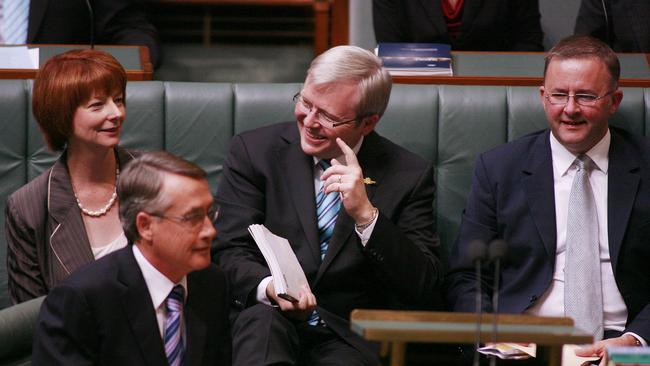GFC stimulus harmed economy, report says
IT TURNS out those $900 cheques weren’t such a good idea after all. Kevin Rudd’s $100 billion GFC cash splash is still hurting the economy.

IT TURNS those $900 cheques weren’t such a good idea after all.
The former Labor government’s $100 billion stimulus package during the GFC has been slammed in a scathing new Treasury-commissioned report, which argues the cash splash actually weakened the economy and damaged local industry by overvaluing the exchange rate.
The report, authored by economist Tony Makin from Griffith University, says the Rudd government's fiscal stimulus was “unnecessarily large” and “misconceived because it emphasised transfers, unproductive expenditure such as school halls and pink batts rather than tax relief and/or supply side reform”.
The latter occurred in New Zealand, where “marginal income tax rates were reduced, infrastructure was improved and the regulatory burden on business was lowered”.
“In sum, fiscal stimulus was not primarily responsible for saving the Australian economy from a narrowly defined recession in the March quarter of 2009, but a combination of lower interest rates, a major exchange rate depreciation, strong foreign demand for mining exports, especially from China, and a then more flexible labour market,” the report says.
“Fiscal stimulus later weakened the economy by strengthening the exchange rate and reversing the contribution net exports made to aggregate demand.
“Commodity prices quickly rebounded in 2010-11, soon after the worst of the GFC had passed, to reach new record highs. At that time, a cut in government spending would have been the most appropriate fiscal response to boost business confidence and take upward pressure off the exchange rate.
“Prolonged overvaluation of the exchange rate seriously worsened Australia’s international competitiveness and harmed industries in the tradeable sector, especially manufacturing.”
The failure of successive governments to rein in spending has led to Australia experiencing one of the fastest rises in public debt in the world since the GFC, the report says, and budget deficits have persisted for longer than previous fiscal stimulus episodes in the ‘80s and ‘90s.
Australia’s subsequent fiscal repair has been weaker than the US, UK, New Zealand and Europe.
“Interest paid by the federal government on its outstanding debt was under $4 billion before the GFC yet could reach $20 billion, or 1 per cent of GDP, by the end of the decade,” the report says.
“The servicing cost on foreign debt incurred to fund unproductive expenditure is a net drain on national income and on future budgets, and could potentially spark a vicious circle of deficits and debt if world interest rate rises combine with an interest risk premium that eventuates from a credit rating downgrade.”
It points out that public debt interest now exceeds expenditure on the Pharmaceutical Benefits Scheme, unemployment benefits, higher education and foreign aid.
The report comes after shock GDP figures this week which showed the economy contracted by 0.5 per cent in the September quarter — its first decline since March 2011 — dragging the annual rate down to 1.8 per cent.
“Federal government spending, unlike state government spending, is overwhelmingly recurrent, including a large social welfare component which does not generate a return to the government to service the debt incurred to fund it,” the report says.
“Fiscal consolidation focused on reducing recurrent government spending would exert downward pressure on market interest rates, lower foreign take up of government bonds, weaken the exchange rate and lift international competitiveness. At the same time, revenue neutral tax reform would improve productivity and growth in the long run, particularly company tax cuts that raise the economy’s capital stock.”




